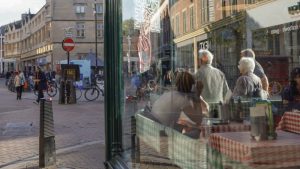good wine and complicated vintages
If there is a constant undercurrent in the Italian wine world, it is the consciousness that France got there first — even though that is not true if one considers ancient rather than modern history.
Federico Moccia and Nelson Pari are respectively the current and past sommeliers at the wine-themed London club 67 Pall Mall. Both are Italian and think the wines of their home country deserve the sort of “10 Years Later” tastings that are held every year in London for the wines of Bordeaux. They have accordingly just organised such a showing for some of the top wines of Tuscany from 2014.
The only unfortunate thing was the timing of their idea. The 2014 growing season in northern and central Italy was unusually wet and cool with rampant mildew. The booklet that accompanied the tasting described 2014 as “the last truly rainy vintage in Italy”. The wines themselves have the reputation of being lean, sometimes mean, and likely to mature much earlier than those made in other years. So 2024 didn’t look like the most promising year to start the custom of holding an annual 10 Years Later tasting.
Still, Moccia and Pari were determined. First, they secured the backing of the Italian Cultural Institute in Belgrave Square, in whose airy, sun-filled, first-floor room the tasting was held earlier this month. Then they approached the estates they most admired in Chianti Classico and Montalcino (home of Brunello) in the Tuscan hills and Bolgheri on the coast asking them to donate bottles of their 2014s.
The wines, 10 from each region, mostly came from the wine producers’ museum and library collections, in which the 2014 vintage is unlikely to occupy an especially glorious place. Several producers were “too scared to show their wines”, according to Moccia. And Poggio di Sotto in Montalcino, for instance, insisted on tasting their 2014 Brunello themselves before agreeing to play ball.
Although Italy is famous for hosting an annual series of Anteprima tastings of just-released wines for virtually every important wine region, opportunities to taste mature vintages are rare. There had never been a similar exercise in Italy, or anywhere else. Rather riskily, Moccia and Pari themselves didn’t taste the wines beforehand. The whole thing could have ended up as a negative publicity exercise for Italy, and I admired those producers who bothered to turn up and pour their wines themselves.
For the most part, they needn’t have worried. Both bottles of Berardenga Chianti Classico Riserva from Fèlsina were oxidised alas, but most other wines, even those from the hills of Chianti Classico which are generally much cooler than Montalcino and Bolgheri, were looking really lovely. They were well balanced and most of them fully mature, although some still had quite a lot to give.
None were overloaded with oak and alcohol in the way some of the wines of the 1990s and early years of this century have been. Raffaella Guidi Federzoni of Fattoria dei Barbi said the wines reminded her of the Brunellos of the 1970s, being fleeter of foot and fresher than some later vintages.
Elisa Sesti, pouring her family’s gentle, subtle 2014, said that, because their estate is in the warmer south of the Montalcino zone, their grapes ripened fully even in 2014, adding that the sea air also kept the rain coming in from the north at bay. “Temperatures rebalanced in mid-September and we went on to have an old-school harvest taking us into October,” she said. “We welcomed the elegance and freshness of this vintage.”
The whole point of the exercise was to prove that Italian wines can age. Pari and Moccia have declared themselves happy with the results. Pari pointed out that “doing a classical 10 Years On is not really something in the minds of the Italians. Especially when you ask an appellation to share space with others.” Yet they are already considering mounting similar tastings of mature examples of Barolo, Sicilian wines, perhaps some of Italy’s under-sung white wines such as Verdicchio.
But they are not the only ones determined to demonstrate that it can be worth waiting until wines have reached their peak. A group of wine lovers in London, heavily encouraged by Mosel wine producer Enno Lippold, who is voluble on this topic, has formed a not-for-profit foundation initially called Libération Tardive. They launched it last June with a tasting of vintages of the north Rhône dry white Château-Grillet back to an impressively youthful 2001.
I fear that expecting all wine producers to hold on to vintages until they are ready to drink (which many do in Rioja, admirably, but they are an exception) may be a bit idealistic. The Bordelais upper crust, after all, try to sell their wines long before they are even bottled — with the result that many a mature vintage of bordeaux is much better value than a callow, young one.
But I’m all for encouraging wine lovers not to rush their pleasures, even if it means tying up capital. Most decent winemakers would like to prove that their wines improve with age, even if they know that the majority of their bottles are opened too early. They have therefore been fashioning their wines so that they are enjoyable long before they are at their peak by, for example, ensuring that chewy tannins are not too evident.
The dominant Australian wine producer, Penfolds, has a much better name for the encouragement of keeping corks in bottlenecks and screwcaps unscrewed. Every so often they publish a book called The Rewards of Patience. Since the first edition in 1986, seven more have been published, the last in 2020. The idea is that multiple vintages of their finest wines are tasted by a knowledgeable panel and the notes collated and published to give collectors and the trade an idea of how individual vintages are progressing.
Earlier this month, a few days before the Tuscan 2014 tasting, I was lucky enough to be part of the panel for the next edition, due out next year, as usual under the editorship of my fellow Master of Wine Andrew Caillard. I tasted 21 vintages of their flagship Chardonnay Yattarna back to 2002 (the only one stoppered with a cork); 49 vintages of their most famous red, Grange, back to the first commercial vintage 1952; and an assortment of their very special bottlings including the legendary Bin 60A and multi-vintage blends of Grange.
What a tasting! One that really proved that good wine is worth waiting for and that challenging vintages should not be written off. But I don’t think this is an iron rule. Vintage 2021 was equally challenging for Burgundy’s vignerons and I hoped that it would produce charming, “old-fashioned” wines, a refreshing counterpoint to some of the particularly ripe, dense wines from the unusually hot vintages that preceded that year. That may be the case at some of the most famous addresses but I fear it’s not a widespread phenomenon. Too many 2021 red burgundies I have tasted so far are a little bit too lean. But perhaps I am judging them too early and, that in this case too, patience will be rewarded.
Top 2014 Tuscans
I scored all of these at least 17 out of 20 and have included UK stockists where available.
CHIANTI CLASSICO
-
Castello di Ama, San Lorenzo, Gran Selezione (13%)
£39.99, T Wright Wine -
Mazzei, Castello di Fonterutoli (13.5%)
£154 for three magnums, Blanco & Gomez -
Montesecondo (12.5%)
-
Querciabella, Riserva (14.5%)
£216 for six bottles in bond, Fine Wines For All -
Riecine (12.5%)
BRUNELLO DI MONTALCINO
-
Casanova di Neri (14%)
-
Il Marroneto (13.5%)
£61.41, Lay & Wheeler -
Le Potazzine (13.5%)
£54.21, Lay & Wheeler -
Le Ragnaie, Vecchie Vigne (Rosso di Montalcino, not Brunello) (13%)
-
Poggio di Sotto (13%)
£865 for six bottles in bond, Crop & Vine -
Sesti (13.5%)
£226.50 for six bottles in bond, Clarion Wines
BOLGHERI SUPERIORE
-
Argentiera, Argentiera (14.5%)
£150, Hard to Find Wines -
Fabio Motta, Pievi (Bolgheri Rosso, not Superiore) (13.5%)
-
Grattamacco (14%)
-
Mulini di Segalari (13%)
-
Ornellaia (13.5%)
£170, Cult & Boutique Uncorked -
Poggio al Tesoro, Sondraia (14%)
Tasting notes, scores and suggested drink dates on Purple Pages of JancisRobinson.com. International stockists on Wine-searcher.com
Follow @FTMag to find out about our latest stories first and subscribe to our podcast Life and Art wherever you listen
#good #wine #complicated #vintages




